| KALAMAZOO
ANTIQUE BOTTLE CLUB NEWS |
| Volume 21 Issue 6
Written By Allan C.Holden
February 2024
|
| I Hear That Show Train A-Comin’!  OK, I know, you must be growing tired of that old ‘Folsom Prison’ analogy, but it has always seemed appropriate this time of year. My version goes; “ I hear that train a comin', it's rolling 'round the bend, I ain't seen the sunshine since . . . well, I don't know when. I'm stuck in Kalamazoo, Michigan, inside a dark and gloomy room . . . hoping each and every day . . . the show will be here soon! Ya, I am not a song writer either! Yes, that greatest of all Antique Bottle Shows! The 2024 Kalamazoo Antique Bottle Show is rolling around the bend! Better get to work with that bastard file and cut through those prison bars! Hurry up and finish that bed-sheet rope! The great show will be here soon! Just think! This will be our 43nd annual Kalamazoo Antique Bottle Show! Amazing! This year’s show takes place from: 10:00 a.m. to 2:30 p.m. on Saturday April 6th at the Kalamazoo County Fair Grounds. The address is, 2900 Lake Street, Kalamazoo, MI 49048 From Interstate 94 take exit 80. For our dealers, a special group rate has been negotiated with, at the Clarion Inn, located at 3640 East Cork Street at exit 80! The Clarion is only 5 minutes from the show location. The Clarion phone number is 269-381-1900. For this special rate, you must call the Hotel prior to Friday, March 24th and mention you are with the “2024 Bottle Show.” Don’t wait! This block of rooms will sell-out quickly! The show hours will have us, closing at 2:30. So, now more than ever, please remain setup until 2:30. The club will be offering a pizza lunch for dealers only! There will be no hospitality suite this year. Dealer setup, will be 8:00 to 10:00 am. Two name tags will be provided per dealer and they MUST BE WORN. Dealers must furnish their own table covers. Table Covers Are Required! For-Sale items will be limited to: Antique bottles, jars, flasks, and related glass. Also marbles and stoneware, advertising and small table-top antiques are permitted. PLEASE! No flea-market items, no Avion Bottles, new merchandise, Jim Beam bottles, beer cans, etc. Tables should consist of at least 60% bottles, flasks, jars or related glass. Any modified, repaired and irradiated bottles, or jars, must be clearly marked! Notes by: Mr. Vincent Grossi Vince has been helping me with meeting notes, which is greatly appreciated! This month Vincent sent mainly administration reminders for the club board to discuss. Also, one of our old friends, Ethan May, has had a change of address. Glad to hear you are still bottle hunting, Ethan! Also, we have been working on a foul-weather cancellation policy. We actually had one that was decided by the Kalamazoo Public Library from when we had been meeting there. It sounds to me like a good solid policy, one that makes real good sense. When the Kalamazoo, and or, Otsego Schools are closed due to bad weather, we will not be meeting. However please note; If those same schools are closed due to an outbreak of head lice, very likely brought on by some local un-washed privy digger, we will plan on meeting and picking through each others scalp! Don’t miss the fun! One of our new members, Ashley Carlson works in advertising. Ashley made up a advertising flier for the club show and I love it! I am going to add a print copy to this mailer, and a digital copy when I build the web newsletter. Thank you Ashley! 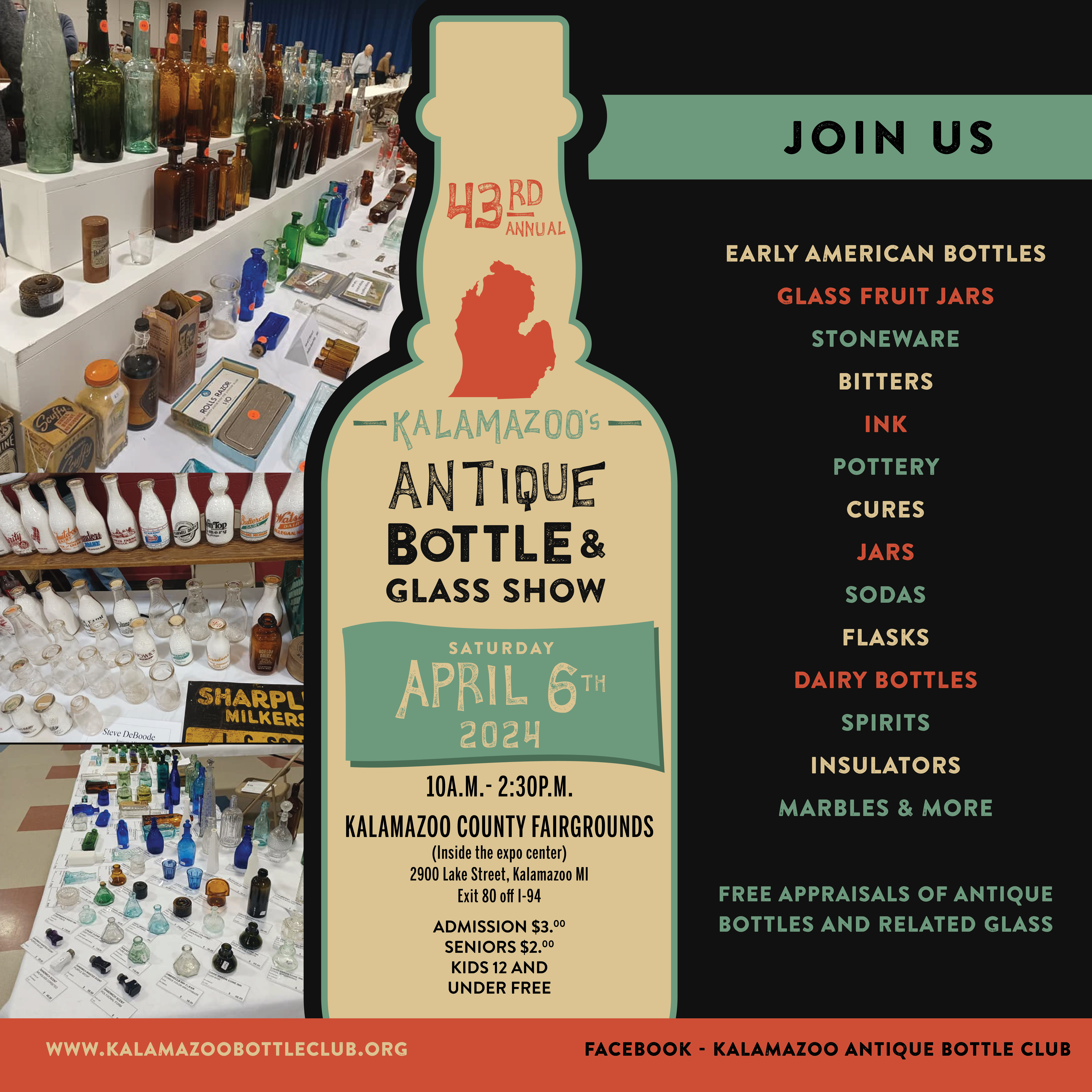 LAST MEETING You guessed it! We had a lot of fun at the January Meeting! Looking about the room we saw the following smiling faces! Dave Wilkins, Scott Hendrichsen, Kevin Siegfried, Gary Dean, Vincent Grossi, Ed Nickerson, Len Sheaffer, Ashley Carlson and Al Holden. MEETING BOTTLES We had a great fun with viewing and exchanging bottles! I personally scored some fun bottles! If you remember back to our December meeting, Kevin Siegfried displayed two cobalt-blue paneled, open-pontil mineral water bottles . . . one with a broken and repaired lip. 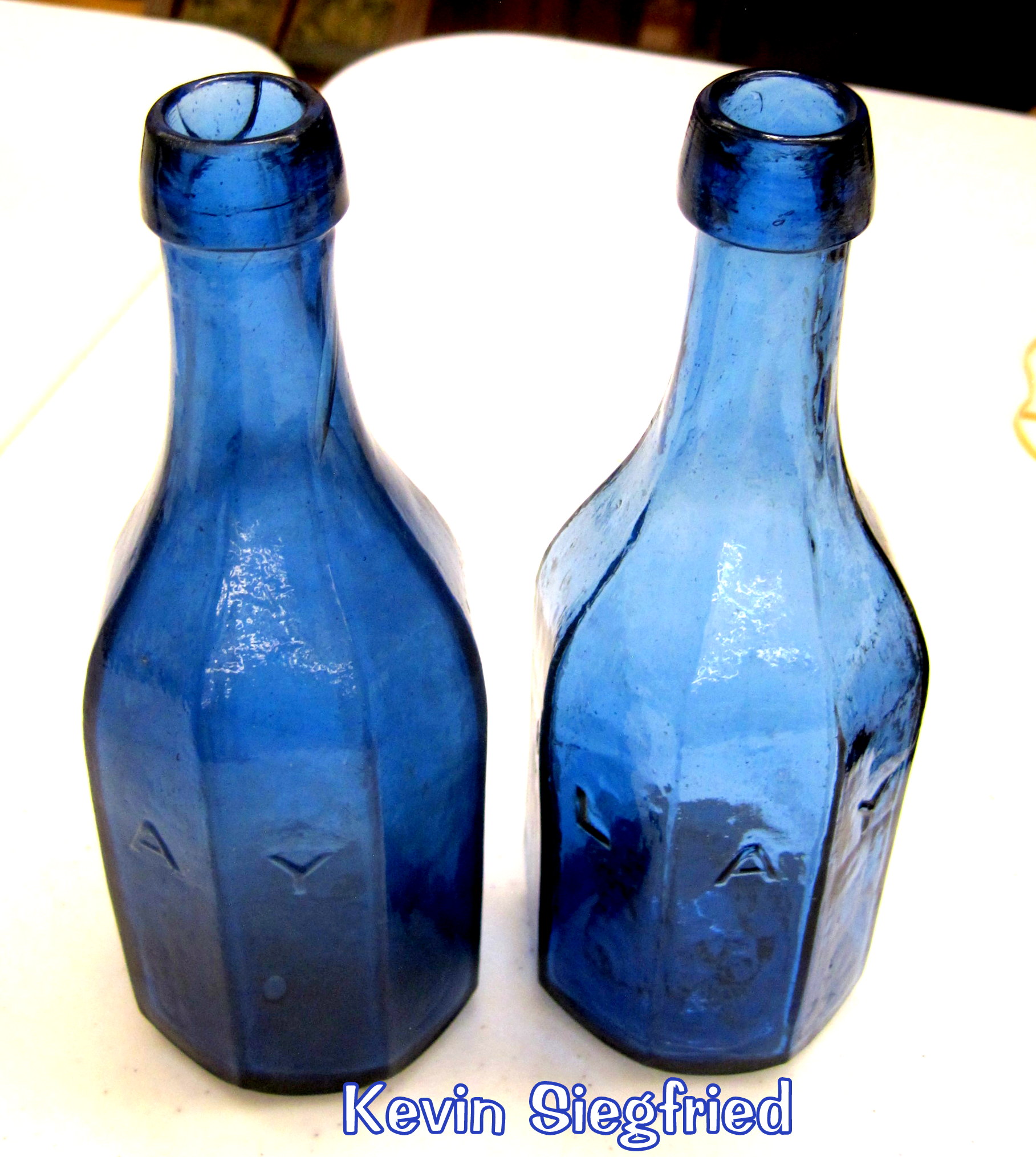 They are both embossed “J. LAY.” Kevin consigned his unbroken bottle to the American Glass Gallery auction. I was able to make a deal with Kevin on the chipped one! But wait! I am not finished yet! I am still buying poor man’s bottles! Scott Hendrichsen made me a deal on his broken “E. Dexter Loveridge, Wahoo Bitters” bottle. This bottle is what they call a semi-cabin bitters, in a medium amber. Years ago we discovered that these bottles, and the full cabin bottles, like the Drake Plantation and the rare Best Bitters from Kalamazoo, are 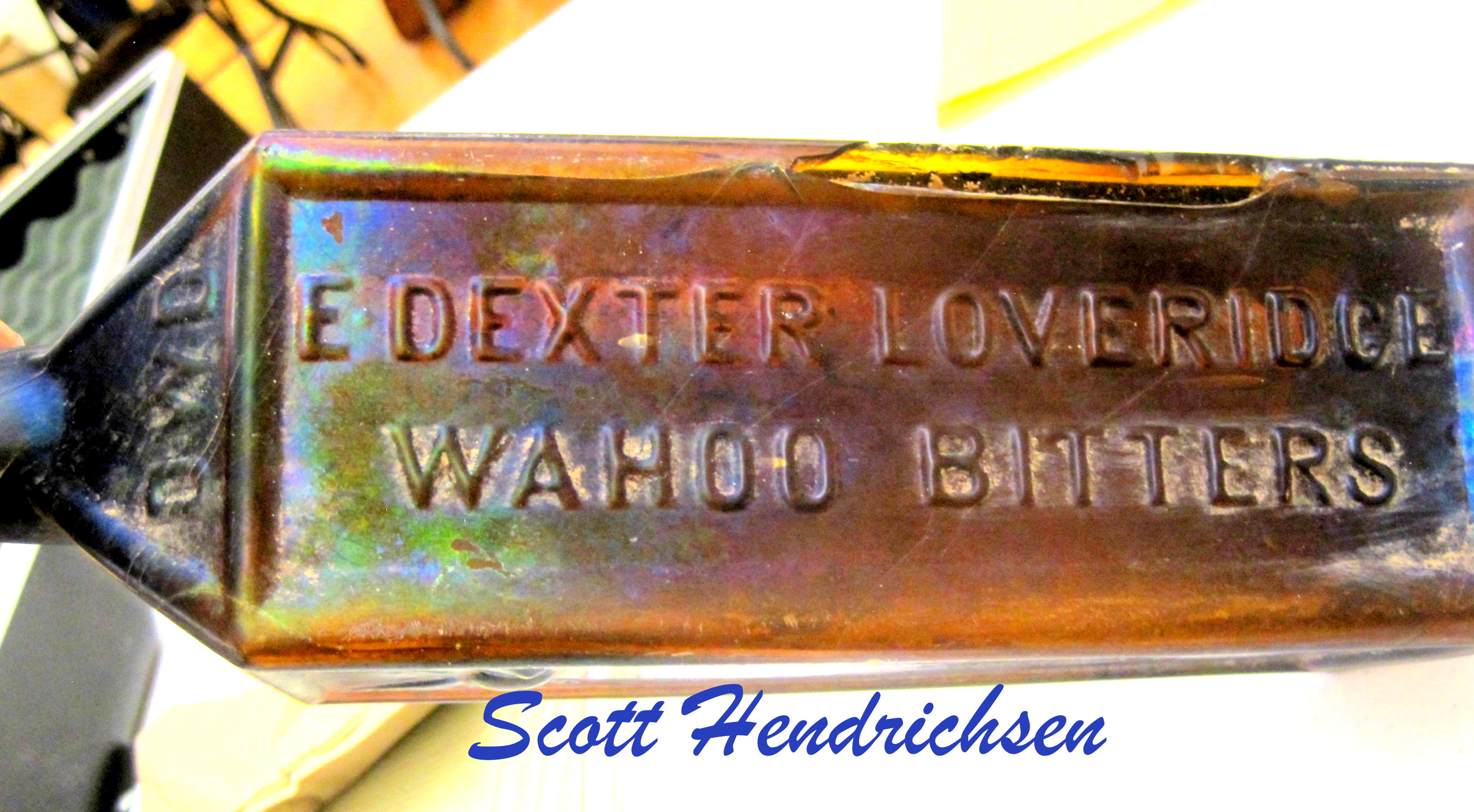 risky bottles to clean in a rotating
polisher. This is because their square corners are
very weak! risky bottles to clean in a rotating
polisher. This is because their square corners are
very weak!This one, even though it is broken, is still free-standing, but sadly, one side corner is almost completely missing. There are some real bottle repair artist out there, where, without the right tools and a good eye, a buyer could be deceived. My repairs and not good and are never meant to fool anyone. I have several hobbies and one is auto restoration and refinishing. I burned myself out on custom painting because I became obsessed with perfection. I have seen brand new cars in a dealer showroom where I would think, “If that was my paint job, I would do it over for free.” Us custom painters have a saying, “A 40 X 60 paint-job.” With most enamels you mix 40% reducer with 60% color . . . . well no, that is not what I am talking about here. A 40 X 60 paint job is one that looks good 40 foot away, going-by at 60 miles per hour! That pretty well describes my bottle repairs! I don’t really restore bottles . . . but rather re-purpose them. If I am lucky, I will have that Wahoo Bitters at the February meeting . . . I think you will like it. 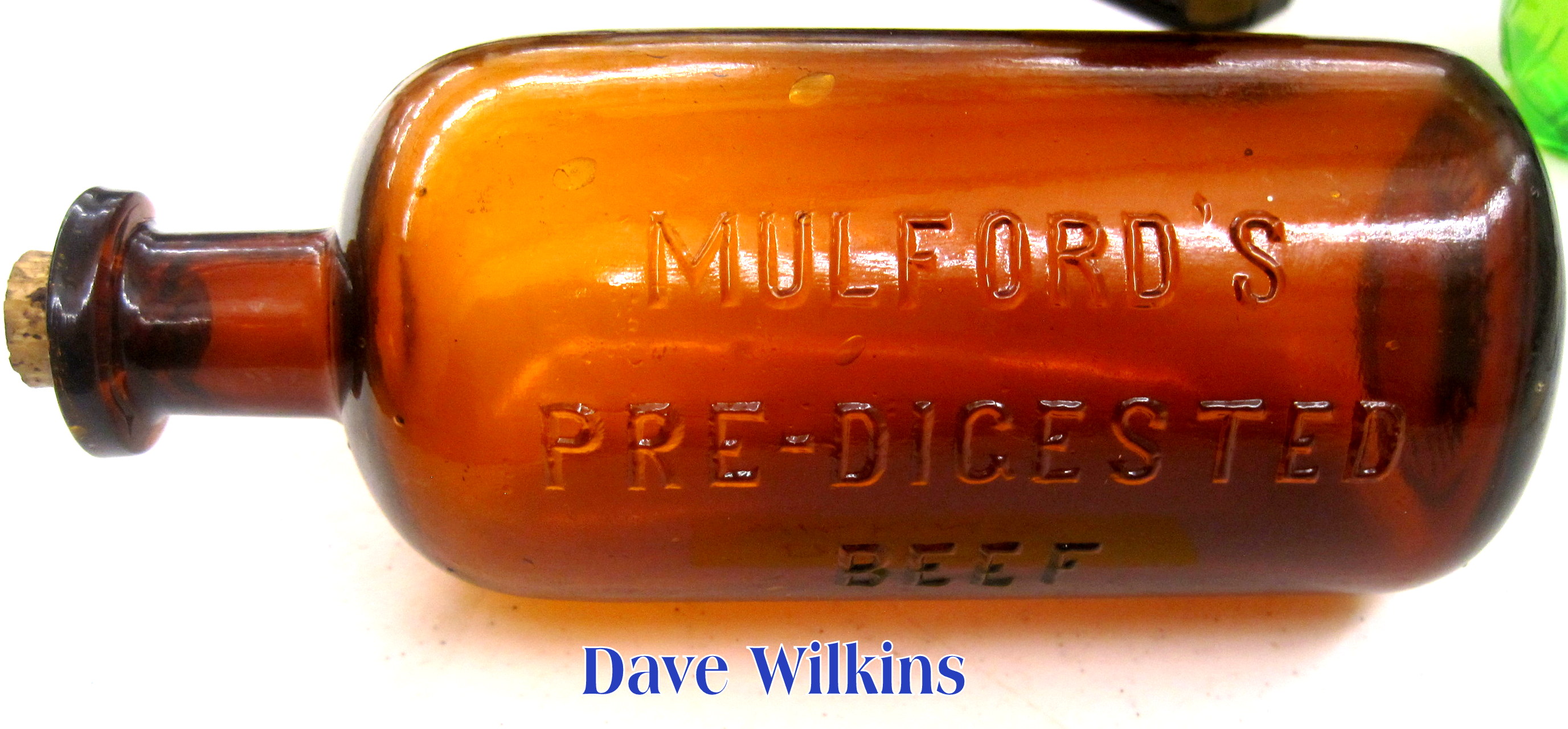 Dave Wilkins displayed some beautiful bottles at the meeting! Three were related to the beef industry which the products represented. One was: MULFORD’S PREDIGESTED BEEF. We dealt with this product several years back. In my mind, this product has a Otsego MI connection. Even though the Mulford product was from New York, Philadelphia, and Chicago, it originated first, around America’s biggest stockyard, located in South Chicago. The Union Stock Yard & Transit Co., or “The Yards,” was the meat packing district in Chicago starting in 1865. 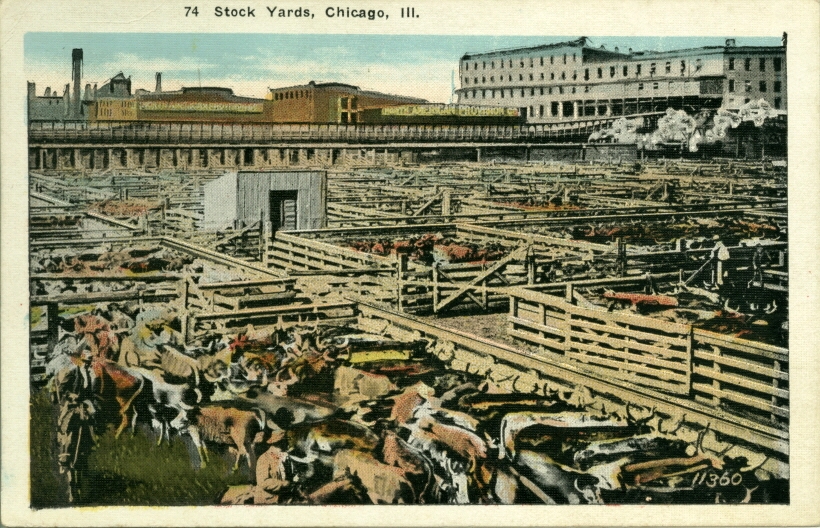 The district was operated by a group of railroad companies that acquired marshland and turned it into a centralized processing area. By the 1890s, the railroad money behind the Union Stockyards was Vanderbilt’s money! Back in Allegan County Michigan; when you drive though Otsego, it is hard not to notice that the space across main street is wide enough to support a 5 lane highway plus parking! One might think the founders of Otsego were so forward thinking, they envisioned traffic congestion nearly 300 years in the future? Not at all, Otsego was a cattle town! Otsego was the rail hub that fed cattle into the massive Chicago Stock Yards. After arriving from Germany, working for a Detroit Dairy, making them rich by his premium cottage cheese, my grandfather decided to launch off on his own. But first, he studied the Michigan cattle production to locate the greatest number of milk producers . . . In 1926 . . . Otsego was a no brainer! Otsego became the home of the Michigan Cottage Cheese Company. Both beef and dairy farms were abundant all around the area. I gathered from a label photo: “Mulford’s Pre-Digested Beef is a blend of beef, cooked-down to a rich broth, preserved in a wine of 16% alcohol. Each ounce contains predigested beef easily assimilable form of the nutritive substances found in 100 grains of selected lean beef. The product was made for conditions of enfeebled digestion and malnutrition.” 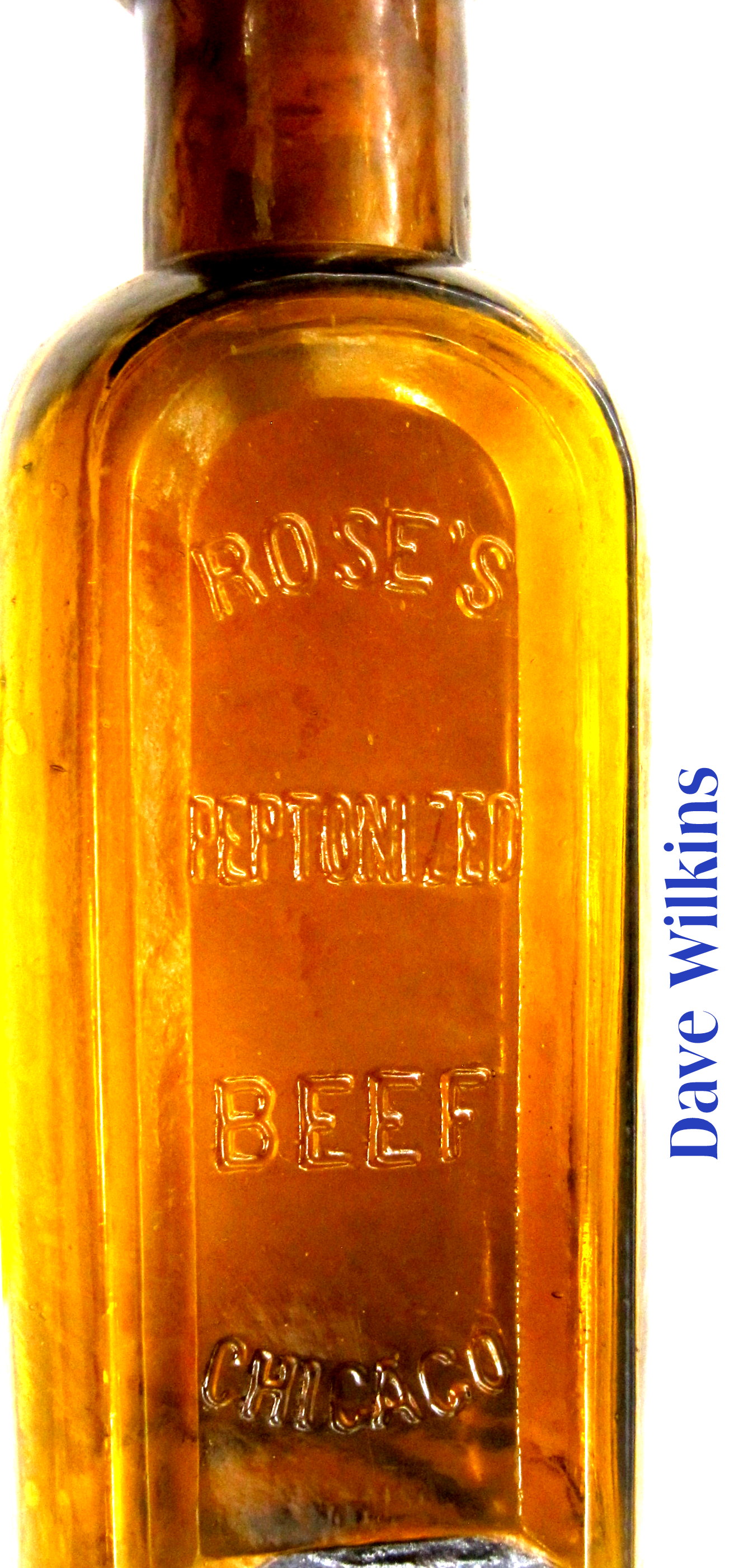 Another bottle Dave shared was also an amber medicine
from the Chicago Beef Industry: “Rose’s Peptomized Beef.”
Another bottle Dave shared was also an amber medicine
from the Chicago Beef Industry: “Rose’s Peptomized Beef.”
I found this product description: “Year-old aged beef bouillon blended with Canadian beer” It was the health remedy peddled by one time University of Michigan urinalysist, Preston B. Rose. This was after he was kicked out of the university. A graduate with the class of 1862, Preston entered UM as an assistant chemistry instructor in the 1860s. He married in 1863. Preston departed from his wife and the university to serve in the Civil War with Michigan’s 5th Infantry Regiment. He worked as assistant surgeon, and was discharged due to his wounds, mustering out in 1865. Back in Ann Arbor, part of Preston’s work involved exposing worthless patent medicines! That work was undertaken with the Washtenaw County Medical Society, which was founded in 1866. The society was mentioned in a 1906 book, “Past and Present of Washtenaw County,” written by Samuel Beakes, who served as mayor of Ann Arbor from 1888-1890. According to Beakes, “the society analyzed many patent medicines, “and exposed their worthlessness.” So, who would benefit from products like predigested protein? Well, something simiular kept me alive! Some of you heard this before. In 2010, I had noticed a small lump under my jaw. My doctor referred me to a specialist who took one look and said point-blank . . . “Al, you have cancer.” To me, cancer was a death sentence. Some are slow, others are fast, but it was death. He said, “If we have caught it early we can fight it.” When I left his examining room, still in the office, everything came crashing down. All my hopes and dreams, my family and so many others who depend on me . . like my widowed mother. Before I left his office I slumped into a bench and wept like a 3 year old that had seen his puppy hit by a car. The very next day, they lowered a camera down my throat. The doctor told me, “This type of cancer usually drops unto the lungs. But, when it does, we don’t call it lung cancer . . . we can treat lung cancer, we can’t treat this stuff. This cancer, if on the lungs is fatal in a couple weeks. It must be aggressively destroyed. Even then, the survival rate is only 7%. At one point I was dealing with 3 great doctors . . . all straight shooters and to the point. So, it was radiation and chemo. Radiation everyday for 6 weeks. I had radiation blisters on the outside of my neck from the burning inside my neck. . . I was cooked . . . microwave style. But here is my point, others had gone before me! Twenty years earlier, anyone with the same cancer, lost their entire lower jaw turning them into a freak! Along with that, their ability to talk and sometimes hear was gone! One of my customers had the same cancer just two years before me, he left the doctor’s office, went home and shot himself. I heard someone say, “Cancer would be cured if it wasn’t so profitable.” Folks, That is a lie from the pit of hell! The very first operation I had was to insert a rubber feeding tube with a flange through a hole in my stomach wall. That rubber tube was hanging out of my belly 10 inches. Once each week a truck from Airway Oxygen would drop off cases of what I called “Green Gunk” I had to use a large syringe to pump this fluid into my stomach tube. I lost over 80 pounds the first month! That open-wound wept blood and puss continually! It was was very confining, especially in bed at night. And when it was finally removed . . . I missed the convenience of it! What was that high energy green gunk? It was similar to Mulford’s and Rose’s Peptonized Beef! Whoever used these bottles that Dave found may have badly needed these products just to stay alive! 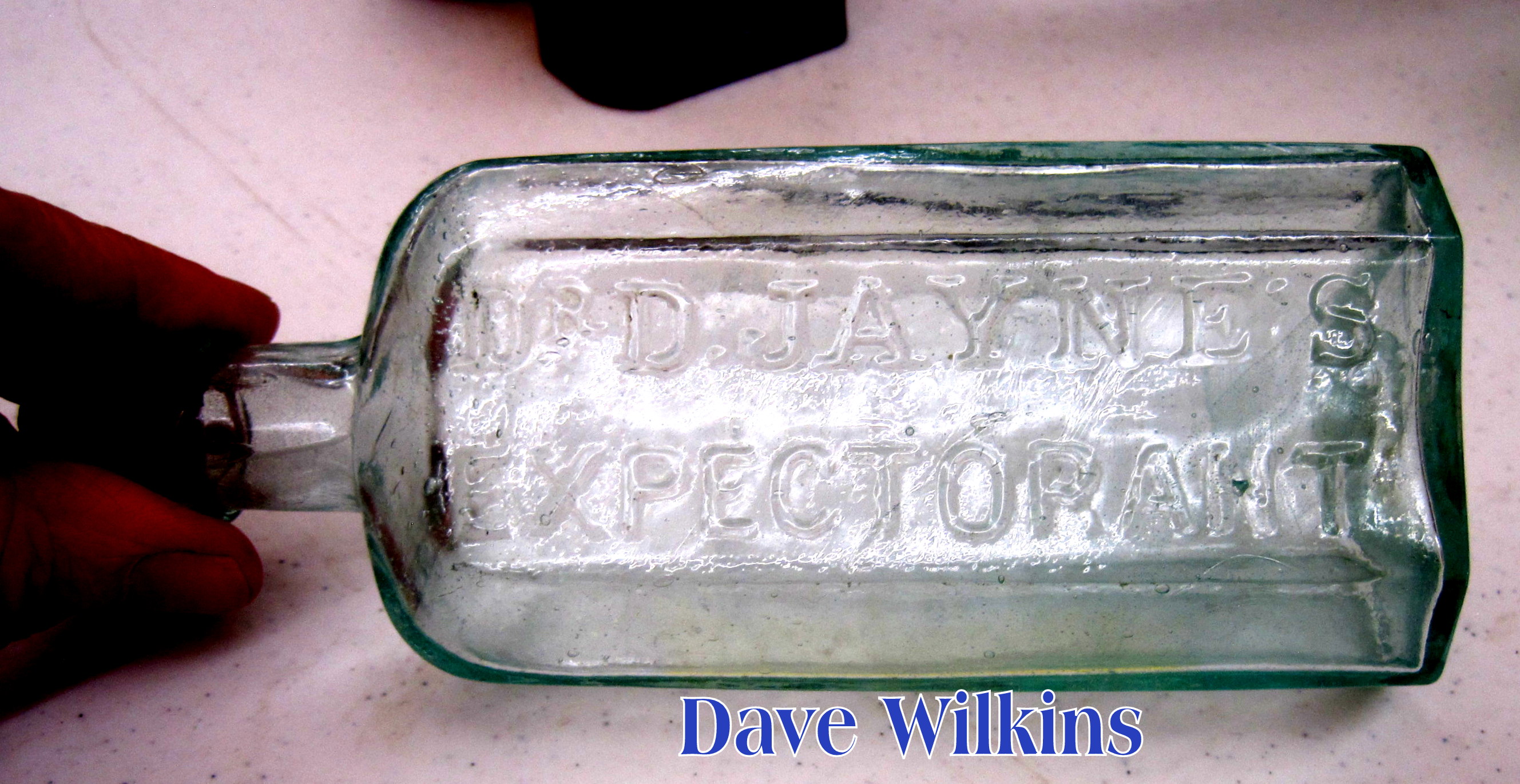 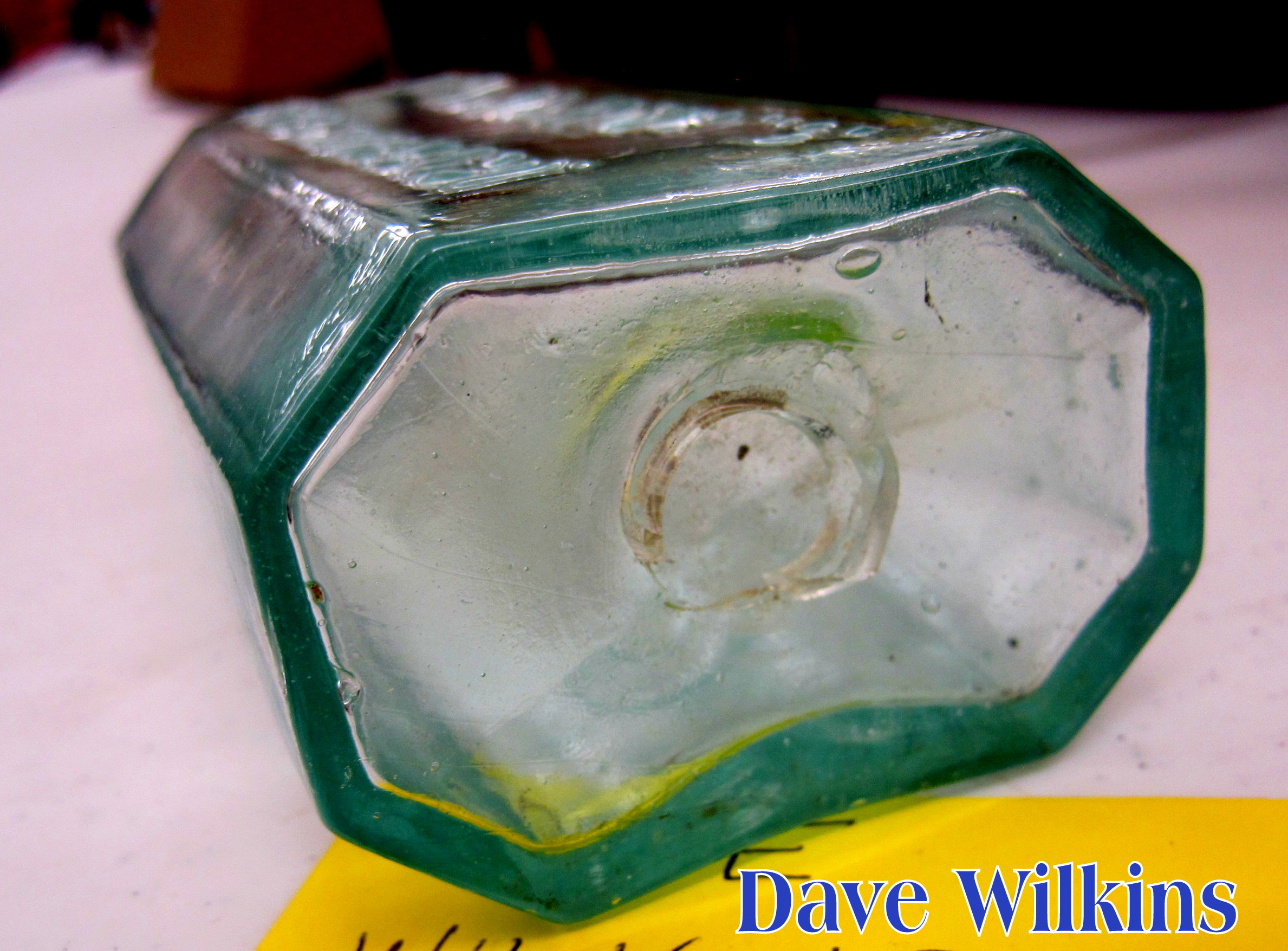 Another sweet bottle Dave showed us is one of my favorites! It is a aqua, whittled Dr. Jayne’s Expectorant with open pontil. Dr. David Jayne, descended from a line of clergymen, and he created the manufacturing empire “ Dr. Jayne's Family Medicines” in the 1820s, initially in New Jersey then in the 1850s in Philadelphia. Dr. Jayne's Expectorant contained: Ipecac, opium, and digitalis were evidently the staple ingredients of his tonics. 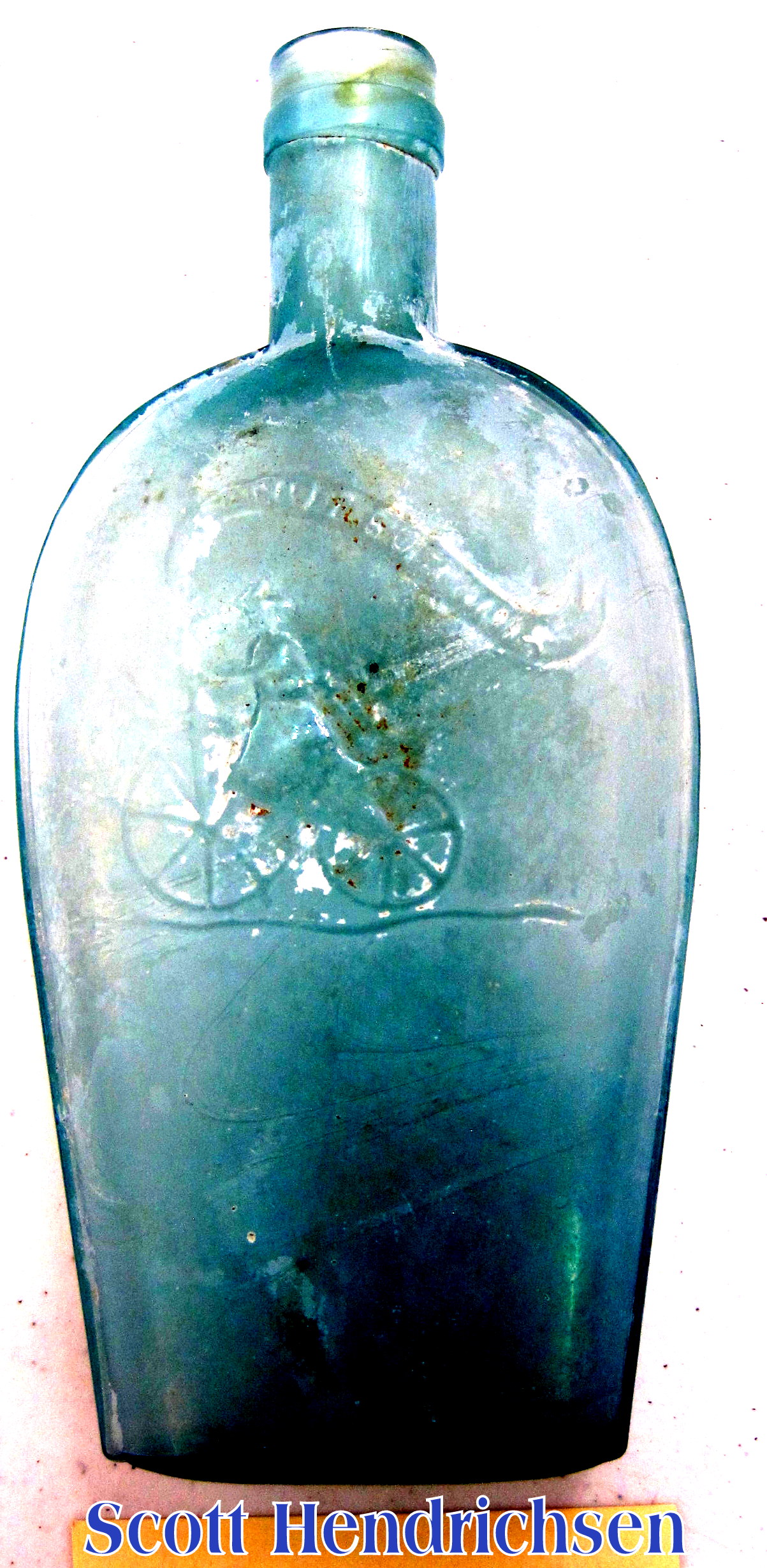 A sweet bottle, Dave! Scott Hendrichsen had a real beauty on display! A aqua blue 1 pint flask with the embossed image of a lady riding a high-wheel bike! She carries a streamer that reads “Not for Joe!” This bottle is a well documented classic assigned number GX III-2 One might get the idea this is “HER” flask 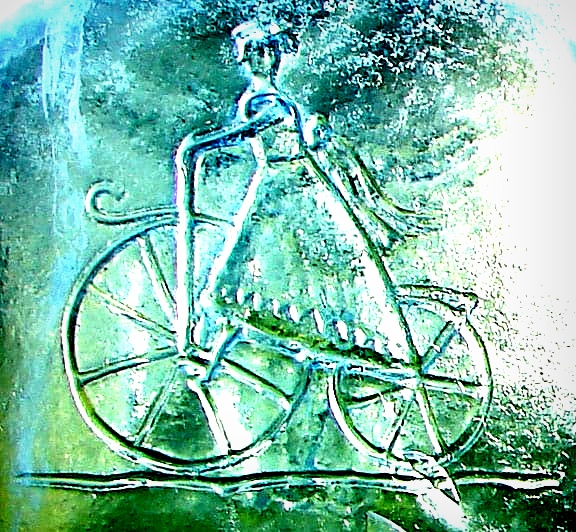 along with the contents
there-in. And, that may well be the marketing approach
at that time! A time when women were women and men
were gay! No, that form of gay. along with the contents
there-in. And, that may well be the marketing approach
at that time! A time when women were women and men
were gay! No, that form of gay. However, another theory is “Not for Joe” was a popular top 40 hit, long before there was a top 40! The song written in 1867, by Arthur Lloyd, a Scottish music hall performer. “Not for Joe” became immensely popular during the early 1870's. On a very wet night, Lloyd jumped onto a bus. The conductor was standing on his perch, talking over the top of the horse drawn bus to the driver. Every now and then, in answer to some remark from the driver, he heard the conductor’s reply, “Not me, not for Joe.” This caught his fancy and before he left the bus I had the chorus and melody complete. 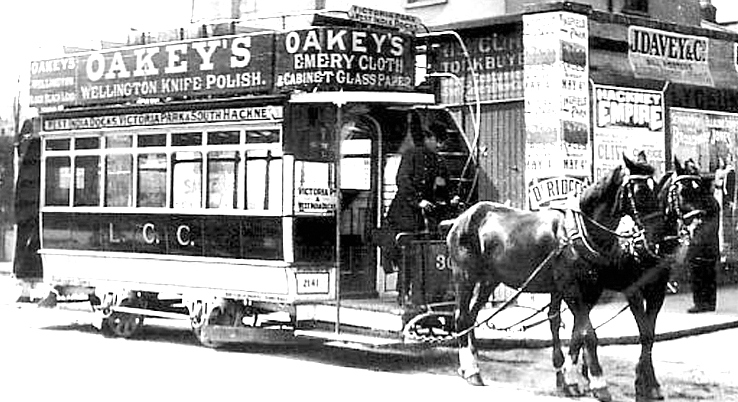 “Joseph Baxter is my name, My friends all call me Joe - I'm up, you know to ev'ry game, And ev'rything I know; Ah! I once was green as green could.be, I suffer'd for it though: Now, if they try it on with me, I tell them, "Not for Joe!" Chorus. 'Not for Joe, 'Not for Joe', If he knows it 'Not for Joseph', No, no, no, 'Not for Joe', 'Not for Joseph, oh,dear no. I used to throw my cash about, In a reckless sort of way; I'm careful now what I'm about, And cautious how I pay: Now the other night I asked a pal, With me to have a drain, 'Thanks Joe' said he, 'lets see old pal' 'I think I'll have Champagne - - -will ye?' Said I, oh, no,- - `Not for Joe!” There you go folks, a great life lesson from 1870 . . . just say NO! Not for _______! Kevin Siegfried always has some cool treasures to display! 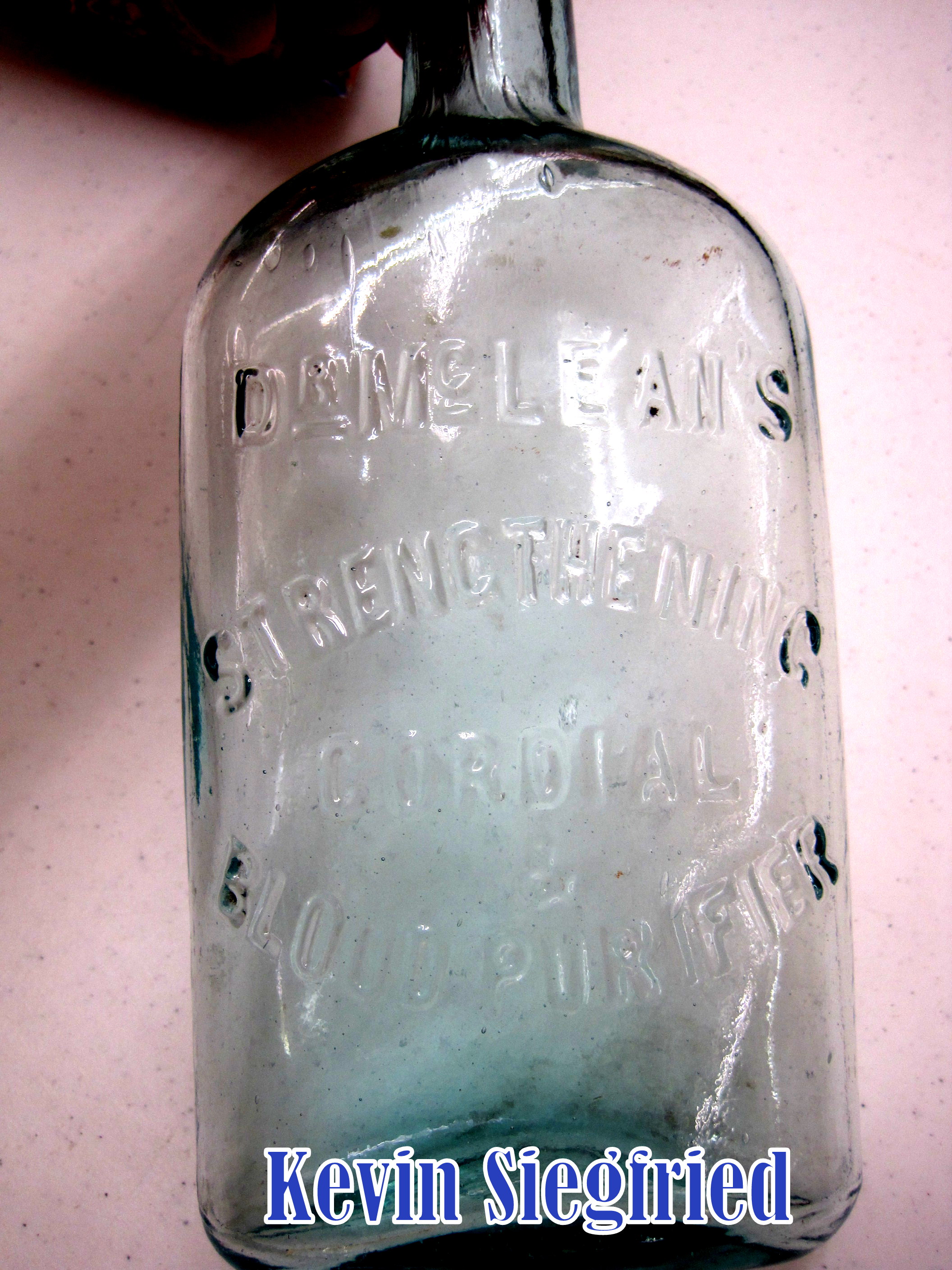 At the last meeting he passed out cool little “folding pocket cork screws” advertising RAWLEIGH’S FOR PAIN ointment! They are so cool! This is why you don’t want to miss a meeting! 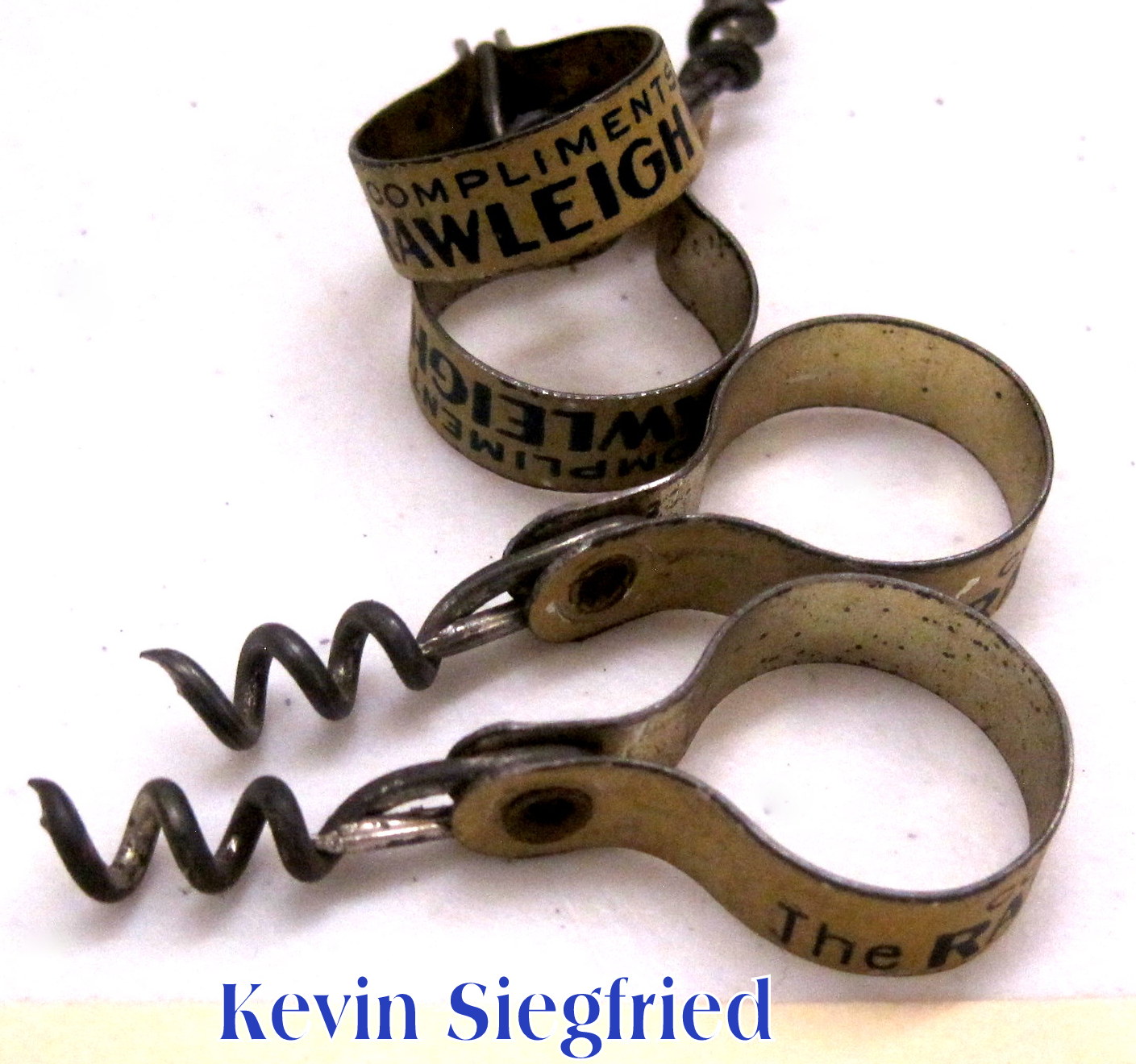 Kevin also has
a beautiful Dr. McLean’s
Strengthening Cordial Blood Purifier! This
bottle is attic-mint with a double collar tooled top!
It is a beautiful deep aqua blue! Kevin also has
a beautiful Dr. McLean’s
Strengthening Cordial Blood Purifier! This
bottle is attic-mint with a double collar tooled top!
It is a beautiful deep aqua blue! Who on earth doesn’t want pure blood?  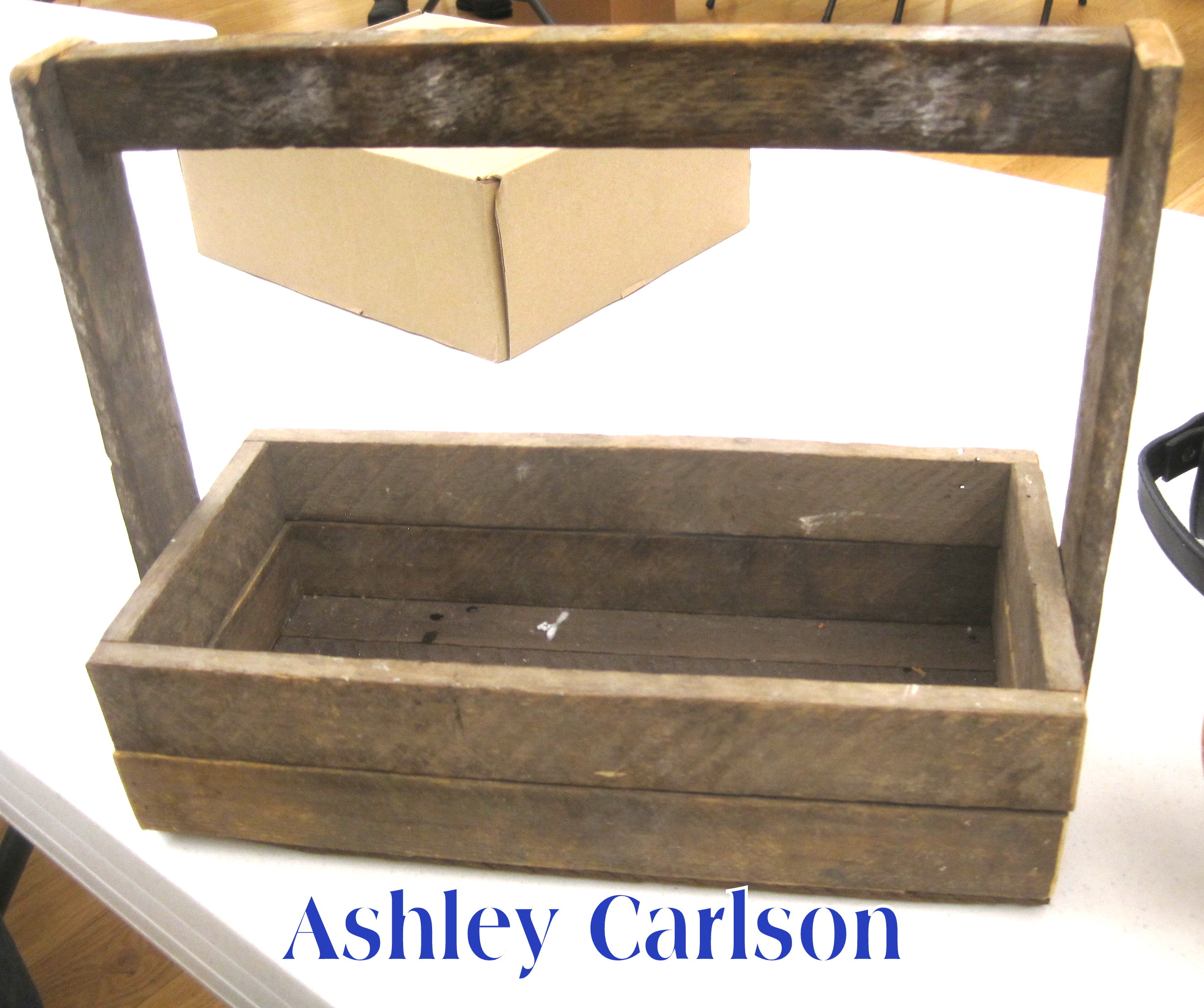 Ashley Carlson brought in a
wooded carrier of glass and clay treasures! I
think the old wooden tote, with its beautiful patina,
was the biggest hit! With her treasures she has a few
items of clay pottery knows as, “Nemadji
Pottery.” Ashley Carlson brought in a
wooded carrier of glass and clay treasures! I
think the old wooden tote, with its beautiful patina,
was the biggest hit! With her treasures she has a few
items of clay pottery knows as, “Nemadji
Pottery.”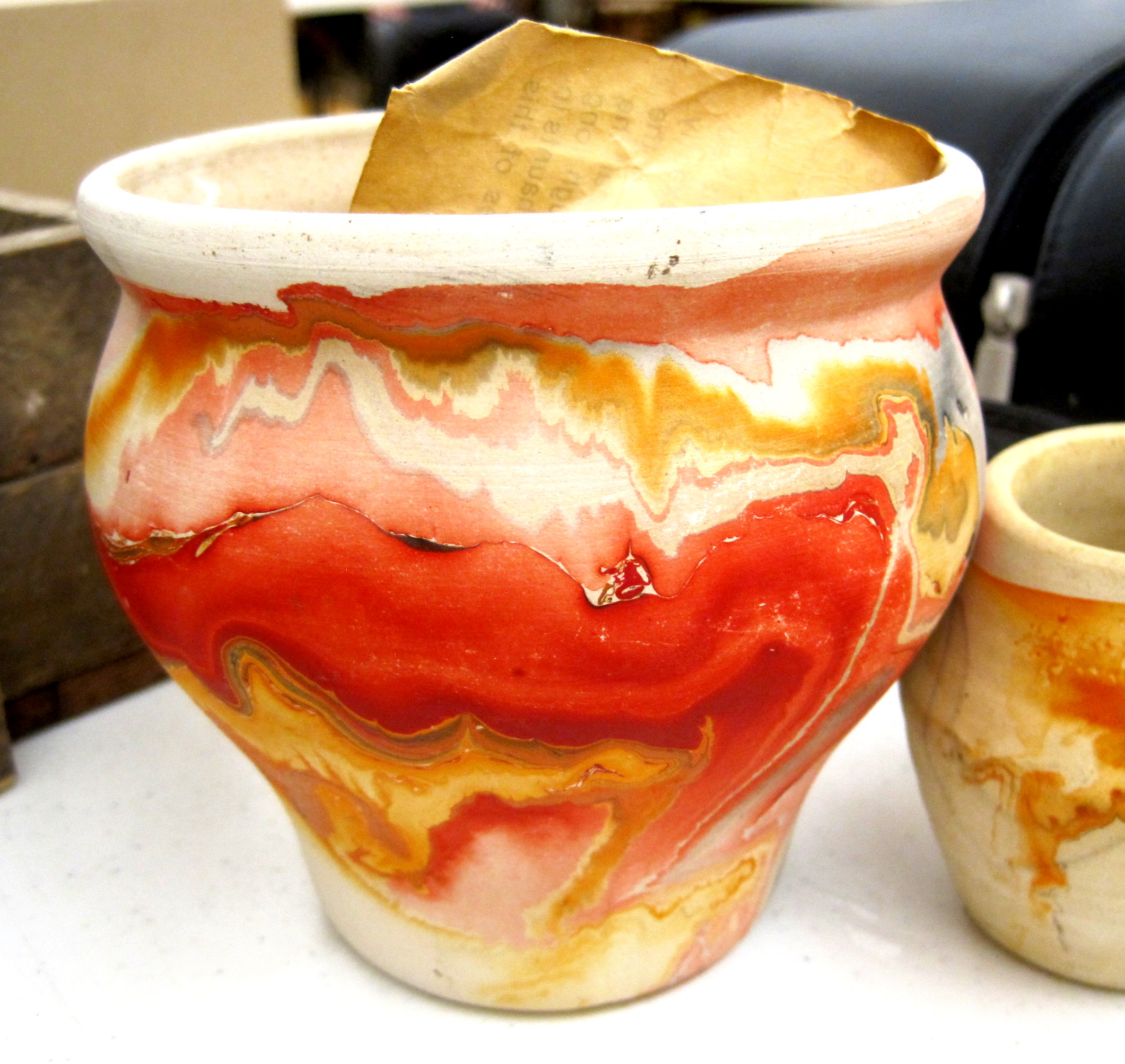 I love the story behind these items. What I am fascinated with, in regard to the dark days of patient medicine and con- 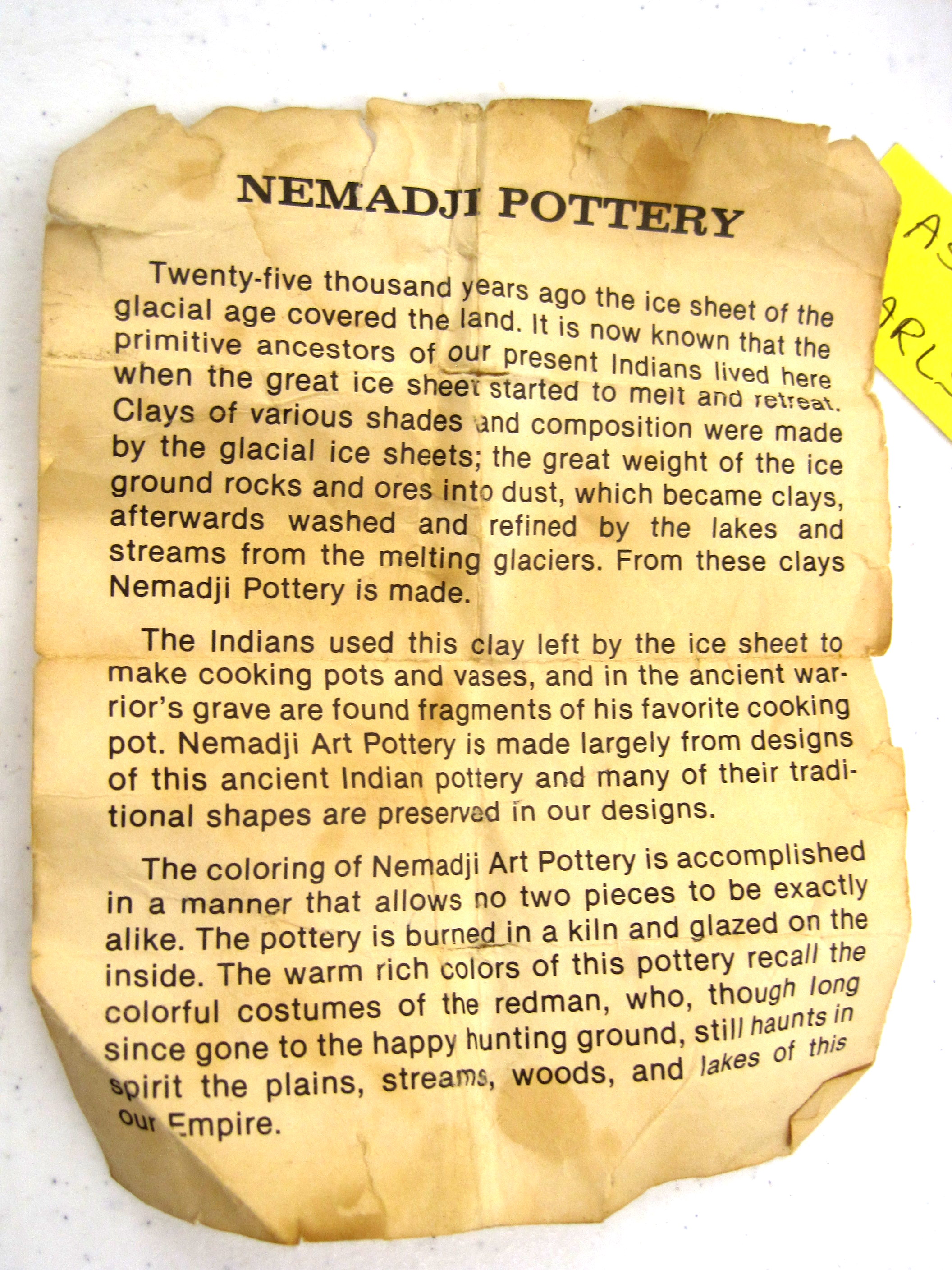 man quackery, is the
ingenious yet evil thinking involved. man quackery, is the
ingenious yet evil thinking involved. Ashley’s very lovely pots came with a paper explaining their history. In this paper they start talking about the retreating glaciers from 25,000 years ago. They explained how the early Indians found that the massive ice formations slowly dragging across the earth, ground-fine and blended an assortment of different mineralized clays, which the Indians used to make beautiful pastel colored pottery. 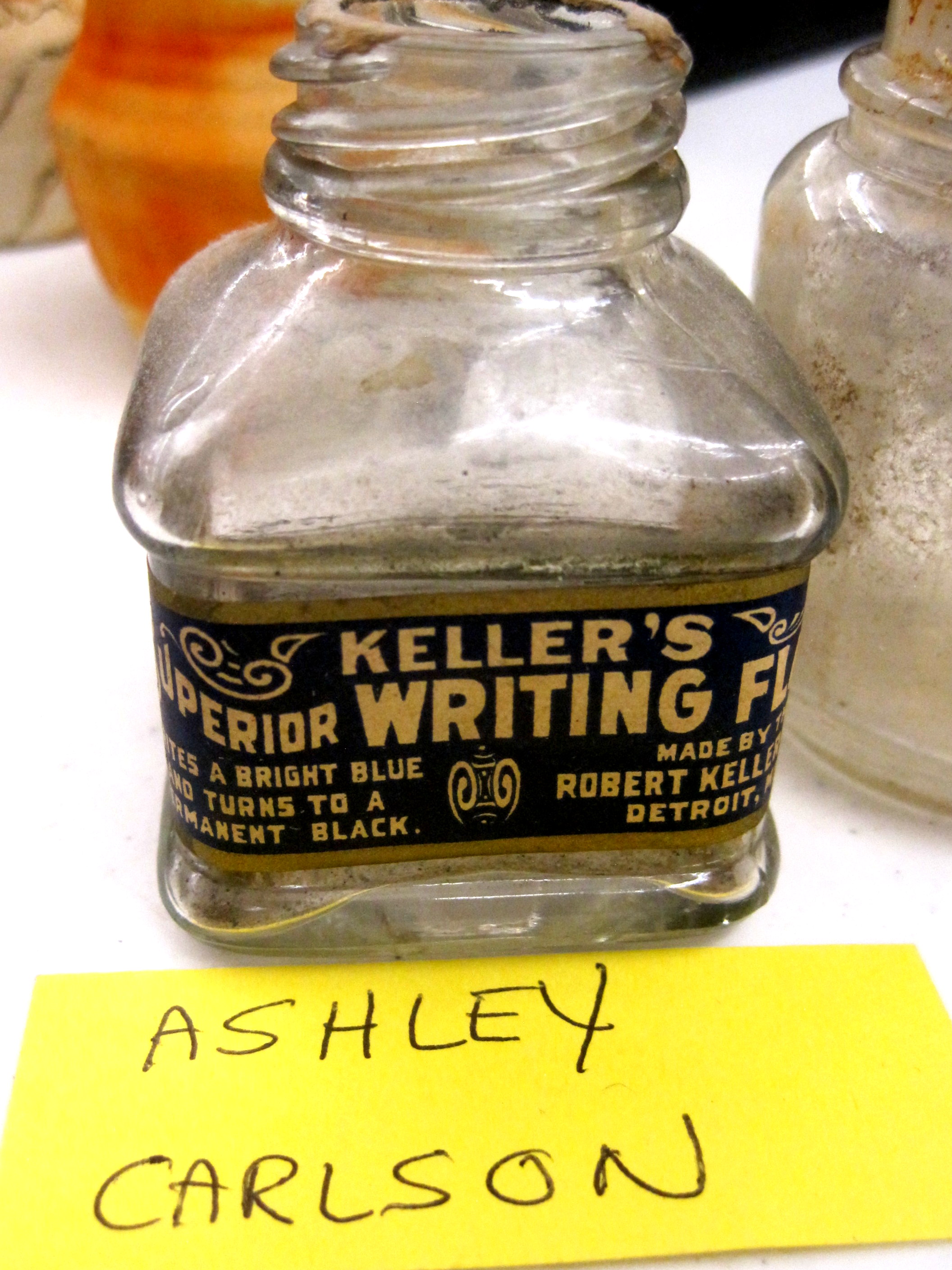 They go on to say the current Nemadji pottery is produced from these same blends of clay to produce the same colorful pots. The name “Nemadji” is an Ojibwe word 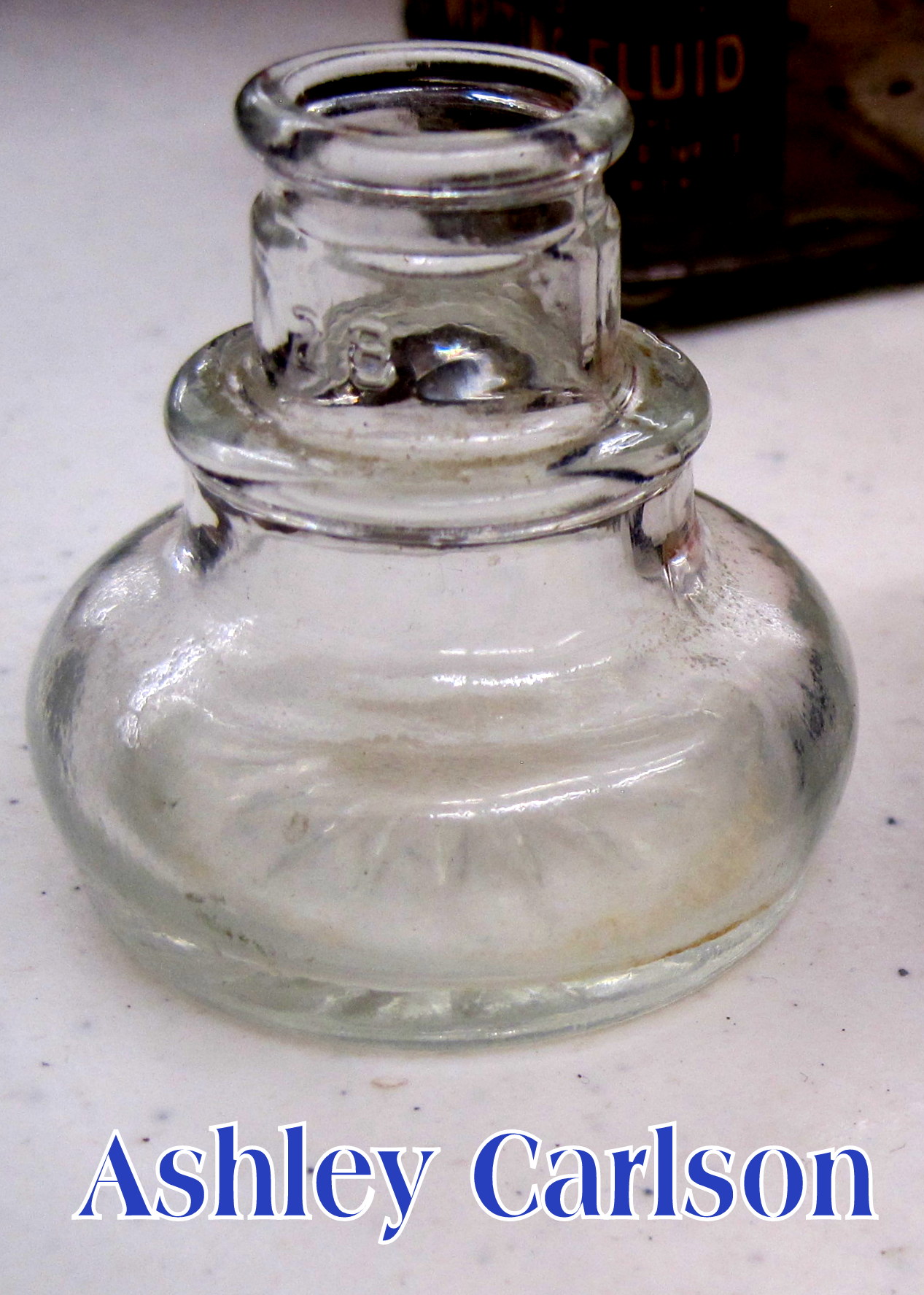 meaning, “left-handed” from the
Indigenous language. Today the word is easily
misunderstood to be the name of a tribe. meaning, “left-handed” from the
Indigenous language. Today the word is easily
misunderstood to be the name of a tribe.Ironically the term “Left Handed” fits very well when you consider the truth behind these vessels. They were built for the tourist trade, but fired with only a glaze on the inside for a reason. That is a good thing if you wish to plant a flower in some dirt. But, the outside isn’t glazed and this is where the tom-foolery comes to the surface. The pots are indeed hand-thrown, most Nemadji pottery was molded from either a tan colored or white clay, fired and left in a bisque (unglazed) state. Then, different colored pastel house paints were floated on top of a vat of water and a small bit of vinegar was added to help separate the paints. Next the fired vase was hand-dipped into the water and swirled in the floating colors. The pieces did not have to be refired because the paint dried quickly, creating uniquely decorated pots every time. (No help from minerals) Yes, they are very pretty, and they do have a collector following! I like them! But you have to admit the pottery is as real as it gets . . . but the story itself is Nemadji, left handed. The company that started making these pieces started in 1929. To determine the approximate date of a piece of Nemadji pottery, take a look at the underside of the pottery. These pieces are usually inscribed with the words "Nemadji Pottery" and some pieces may have a silhouette of a Native American, though some of the earlier pieces feature an arrowhead surrounded by the words. Because the arrowhead examples are generally acknowledged to be among the first pieces of Nemadji pottery manufactured, these pieces with an arrowhead on them are often considered more valuable. Cool stuff, Ashley! |